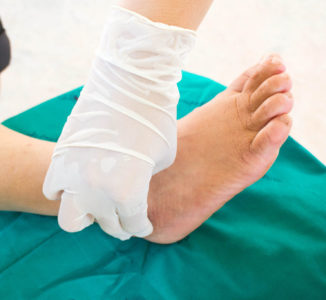 Charcot arthropathy is a condition that involves inflammatory damage to the foot, and left untreated, it can lead to a potential foot deformity. It is not all that common, but that doesn’t mean you should ignore symptoms, especially if you’re diabetic. Below, we take a closer look at the causes, symptoms and treatment options for charcot arthropathy.
Charcot arthropathy is a condition that involves inflammatory damage to the foot, and left untreated, it can lead to a potential foot deformity. It is not all that common, but that doesn’t mean you should ignore symptoms, especially if you’re diabetic. Below, we take a closer look at the causes, symptoms and treatment options for charcot arthropathy.
Causes and Symptoms of Charcot Arthropathy
Charcot arthropathy is actually caused by the onset of another condition – peripheral neuropathy. Peripheral neuropathy occurs when nerve damage, usually in the feet or hands, leads to decreased sensation, limited blood flow and swelling. It is a common problem among diabetics, and this loss of sensation can make it difficult for people to feel certain pain signals in their feet. Pain is our body’s natural way of telling us that something is wrong, so if people continue to walk on their injured foot because they can’t tell that something is wrong, they are at risk for ankle fractures, chronic foot sores or abnormal pressure displacement.
Neuropathy is commonly caused by diabetes, but other conditions like multiple sclerosis, syphilis, syringomyelia, alcoholism and chemotherapy complications can all lead to the onset of peripheral neuropathy. Symptoms of charcot arthropathy include:
- Swelling of the foot.
- Redness.
- Warmth.
- Changes in the bone on X-ray.
- Crookedness to the foot when viewing.
- Lack of sensation in the foot.
Diagnosis and Treatment of Charcot Arthropathy
Charcot arthropathy can be diagnosed by a foot specialist using standard diagnostic techniques, meaning they will ask you about your symptoms, take a look at your medical history, perform a physical exam of the foot and confirm their suspicions using imaging tools like an X-ray or MRI.
Treatment involves casting the foot in order to reduce swelling and limit the shifting of bones in the foot to prevent structural damage. Your cast will be changed on a weekly or semi-weekly basis to ensure the swelling is subsiding, and to check and care for any potential infections. Once swelling has subsided and there are no signs of an infection, a patient will be transitioned to a walking device that helps to displace weight on their foot as appropriate. This may include a custom orthotic device, custom shoes or a charcot restraint orthotic walker (CROW).
For those patients who have a more severe case with a potential foot deformity, surgery is the typical treatment route. Different types of operations are used based on the specific needs of the patient, but they may include an exostectomy, or arthrodesis with internal or external fixation. The goal of surgery is to create a stable foot that can eventually be braced to ensure continued healthy recovery.
The condition is not easy to treat, which is why doctors and patients with diabetes need to perform regular foot checks to ensure everything is in proper working order.